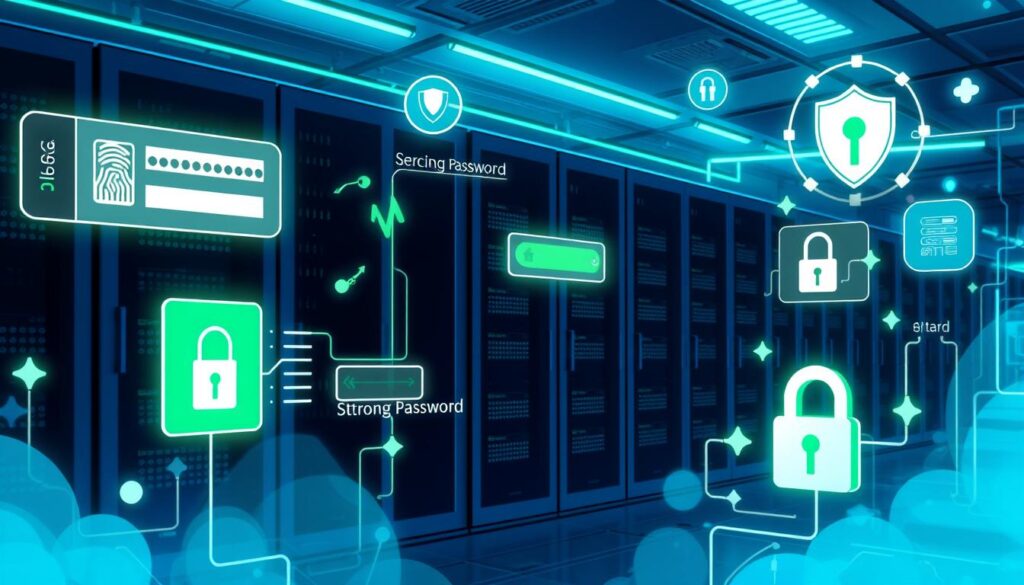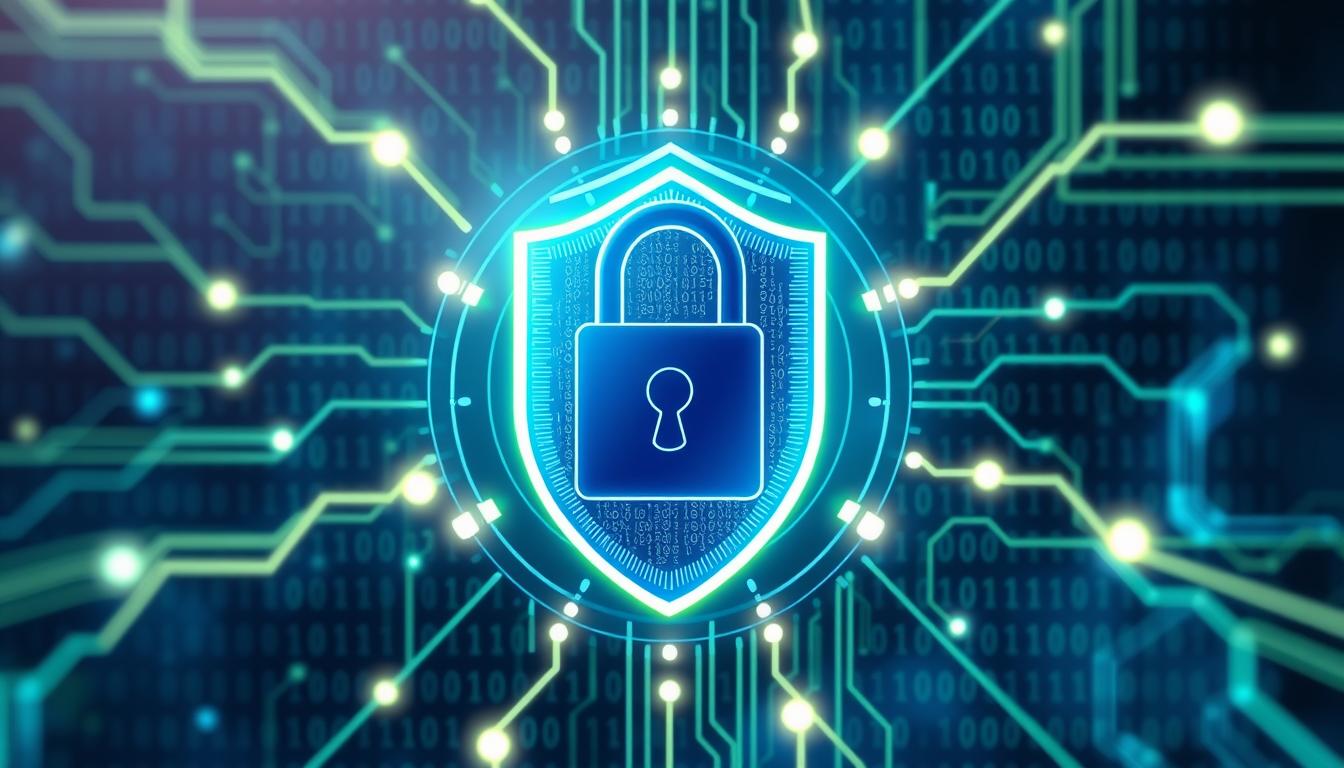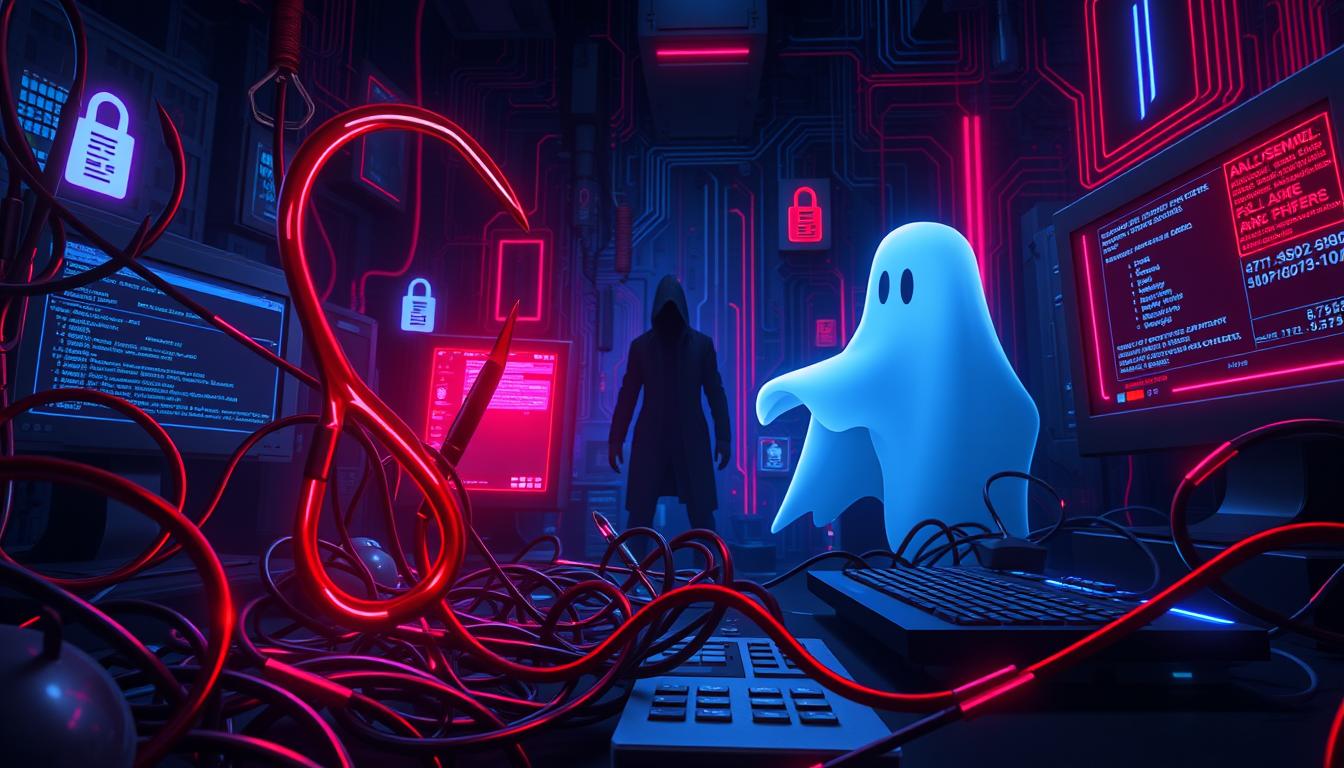The data security industry is booming, growing at a rate of 12.3% each year1. This shows a big need for strong cybersecurity, like keeping data safe and secure. It’s all about fighting cyber threats and making sure data is protected.
As the industry is expected to hit $55.3 billion by 20271, companies must use top-notch cybersecurity. This includes using encryption to keep sensitive info safe. It’s key to keep data confidential and secure.
More than 75% of companies use over 50 different cybersecurity tools1. It’s vital to know how important keeping data safe is. Companies must use strong security measures to stop cyber attacks.
Key Takeaways
- Confidentiality and integrity are key in cybersecurity. They keep sensitive info safe from unauthorized access and tampering.
- Using strong protection, like encryption, is key to keep data safe. It helps prevent cyber threats.
- The data security industry is growing fast, aiming for $55.3 billion by 20271. This shows the need for good cybersecurity practices.
- Understanding the value of keeping data safe is critical. It helps companies protect their info and keep customer trust.
- By using strong security measures, companies can stop cyber attacks. This is essential for keeping data safe and secure.
Understanding the Fundamentals of Confidentiality and Integrity in Cybersecurity
To protect against cyber threats, it’s key to grasp confidentiality and integrity in digital security. SentinelOne explains that the CIA triad is at the heart of cybersecurity2. This framework is vital for businesses to keep customer trust.
Confidentiality means keeping sensitive info safe from unauthorized access. Integrity ensures data stays accurate and unchanged. These are essential for businesses to avoid privacy breaches and keep customer trust. For example, a ransomware attack on Change Healthcare affected hundreds of hospitals and pharmacies, exposing personal health info of about 100 million people3.
Using secure data encryption is a must to safeguard sensitive info. This can be done through encryption, access controls, and physical security. By doing so, businesses can lower data breach risks and protect their data’s confidentiality and integrity. Cybercrime damages are expected to hit $6 trillion by 2021, showing the urgency of strong cybersecurity2.
For more on cybersecurity and protecting your business, check out VinciWorks or Miloriano. They offer insights into the role of confidentiality, integrity, and availability in cybersecurity.
Essential Tools for Maintaining Data Security
Keeping sensitive information safe is key. Creospark says encryption is used for email content and attachments. Tools like S/MIME and PGP are used for this4. Firewalls and intrusion detection systems also help protect against cyber threats.
Important tools for data security include firewalls, antivirus, and encryption5. These tools prevent data breaches, which can cause big financial losses and harm a company’s reputation. Human error causes 82% of data breaches, showing why training and tools are critical4.
Organizations can also use access control, intrusion detection, and SIEM systems5. These tools help spot and handle security issues. By using these tools and strong security measures, companies can keep their data safe and earn customer trust.
Implementing Strong Encryption Protocols
Secure data encryption is key to keeping sensitive information safe. It turns readable data into unreadable code using special algorithms and keys6. This is vital for keeping data private and safe from harm.
Using strong encryption helps lower the chance of data being accessed without permission. For example, strong encryption can greatly reduce the risk of unauthorized data access7. There are two main types: symmetric and asymmetric encryption. Symmetric uses one key for both encryption and decryption. Asymmetric uses a pair of keys for these tasks.
Good practices for managing encryption keys are essential. This includes generating, distributing, and storing keys securely. Following guidelines for encryption, like encrypting data at rest and in transit, helps keep information safe. As data encryption in safeguarding your network shows, encryption is a strong defense against unauthorized access6.
Some important steps for strong encryption include:
- Choosing secure encryption algorithms and protocols
- Following best practices for key management
- Encrypting data at rest and in transit
- Keeping encryption protocols up to date
By following these steps and using strong encryption, organizations can protect their sensitive information. This is critical for building trust and meeting legal standards7.
Access Control and Authentication Measures
It’s vital to have strong access control and authentication to keep sensitive info safe. SentinelOne says using role-based access control (RBAC) and multi-factor authentication (MFA) is key. This makes sure only the right people can see important data8. It follows cybersecurity best practices for protecting sensitive info.
Some important steps for access control include:
- Role-based access control (RBAC)
- Multi-factor authentication (MFA)
- Least privilege principle
- Continuous monitoring of access control systems
These steps help stop data breaches and keep sensitive info safe. They are key to information privacy standards. By using these, companies can cut data breach risks by up to 80%9 and block 99.9% of automated attacks9.
Also, companies should check their access controls often. This helps see if they work well and find any weak spots8. It ensures access controls meet rules like GDPR, HIPAA, and PCI DSS8. By focusing on access control and authentication, companies can keep their data safe and earn the trust of their customers and stakeholders.

Building a Comprehensive Security Framework
Creating a solid security framework is key to keeping sensitive info safe. A good framework spots risks, manages them, and plans for incidents. This is vital for stopping cyber threats and making sure network security solutions work well. Without a framework, businesses face big risks that can shake their stability10.
A strong framework includes risk assessment strategies like scans and tests. It also needs clear policies for handling security issues. Training employees on security helps prevent breaches. Planning for incidents helps organizations react quickly. A good framework cuts down on the chance of cyber attacks11.
Frameworks like NIST Cybersecurity, ISO 27001, and CIS Security Controls are important. They guide in managing risks and keeping info safe. The NIST Framework has core, tiers, and profiles to measure cybersecurity10. The CIS framework has 18 controls to boost security11. Using these frameworks helps protect sensitive info.
Organizations should keep their security frameworks up to date. This means regular risk checks, updated plans, and ongoing training. A proactive cybersecurity approach helps protect against threats. It also keeps customers and stakeholders trusting the business. About 50% of companies don’t have a clear security policy12, showing the need for a solid framework.
Conclusion: Strengthening Your Security Posture for the Future
As companies face the complex world of cybersecurity, keeping confidentiality and integrity in cybersecurity is key. They must use strong encryption, access control, and authentication. This reduces cyber threats greatly.
Encrypting emails and documents with sensitive info is a must. It’s a big step in keeping data safe13. Regular security checks and constant monitoring also play a big role in keeping information secure.
Following top cybersecurity practices and keeping up with new threats is essential. This helps protect sensitive info and boosts security for the future. Using security frameworks, scanning for vulnerabilities, and doing security audits are important steps. These actions not only prevent financial loss but also build trust with customers and partners14.
In today’s digital world, cybersecurity is a must, not a choice. By being proactive and following best practices, companies can keep their sensitive info safe. This way, they can succeed in a secure and changing digital world.
FAQ
What are the fundamental principles of cybersecurity that ensure sensitive information remains protected from unauthorized access and tampering?
The core of cybersecurity is the CIA triad: confidentiality, integrity, and availability. These ensure sensitive info stays safe. They help build trust with customers and stakeholders. This is done through best practices, data security, and encryption.
How can organizations protect sensitive information from unauthorized access and tampering?
To keep info safe, use encryption to scramble data. Also, employ digital security like S/MIME and PGP for secure data exchange. Firewalls and intrusion systems protect against cyber threats.
What is the difference between symmetric and asymmetric encryption?
Symmetric encryption uses one key for both encryption and decryption. Asymmetric encryption uses two keys. Both are vital for keeping data safe. They work best with good key management practices.
Why are access control and authentication measures critical for preventing unauthorized access to sensitive information?
Access control and authentication, like RBAC and MFA, are key. They ensure only the right people get to sensitive info. This stops data breaches and keeps info safe, building trust.
What is a complete security framework, and why is it essential for maintaining the confidentiality and integrity of sensitive information?
A complete security framework identifies risks and develops plans for security incidents. It’s vital for keeping data safe. It includes risk assessments, policy development, and employee training.
How can organizations build a complete security framework to maintain the confidentiality and integrity of sensitive information?
Start by identifying risks and implementing strategies. Develop plans for security incidents. Use best practices, like encryption and employee training, to prevent breaches.
What are some best practices for maintaining the confidentiality and integrity of sensitive information?
Use strong encryption and digital security protocols. Implement access controls and employee training. These steps help keep data safe and prevent breaches.
Source Links
- Top 10 Cyber Security Principles For Businesses – https://www.sentinelone.com/cybersecurity-101/cybersecurity/cyber-security-principles/
- Understanding the Fundamentals of Information Security – https://www.eccu.edu/blog/cybersecurity/fundamentals-of-information-security/
- What’s The CIA Triad? Confidentiality, Integrity, & Availability, Explained | Splunk – https://www.splunk.com/en_us/blog/learn/cia-triad-confidentiality-integrity-availability.html
- Understanding Data Security Tools, their Capabilities, and Why They Are Important – https://www.digitalguardian.com/blog/understanding-data-security-tools-their-capabilities-and-why-they-are-important
- What are the most essential tools for Data Security Tools – https://www.linkedin.com/pulse/what-most-essential-tools-data-security-dan-spranceana-phd
- The CIA Triad: Confidentiality, Integrity, Availability – https://www.veeam.com/blog/cybersecurity-cia-triad-explained.html
- What is the CIA Triad? | Definition from TechTarget – https://www.techtarget.com/whatis/definition/Confidentiality-integrity-and-availability-CIA
- What is Access Control? Types, Importance & Best Practices – https://www.sentinelone.com/cybersecurity-101/cybersecurity/what-is-access-control/
- What is Access Control in Cybersecurity? | NordLayer Learn – https://nordlayer.com/learn/access-control/what-is-access-control/
- Cyber Security Framework: Definition and Best Practices – https://www.sentinelone.com/cybersecurity-101/cybersecurity/cyber-security-framework/
- Cybersecurity Frameworks: What They Are & How to Use Them | Splunk – https://www.splunk.com/en_us/blog/learn/cybersecurity-frameworks.html
- Creating an Information Security Policy Framework: A 5 steps guide – https://community.trustcloud.ai/docs/grc-launchpad/grc-101/governance/creating-a-simplistic-information-security-policy-framework-a-step-by-step-guide/
- Assessing and Improving Security Posture is Critical to Good Cyber Hygiene – https://www.linkedin.com/pulse/assessing-improving-security-posture-critical-good-cyber-robert-bond
- The Strategic Benefits of Cybersecurity Compliance – https://www.nri-secure.com/blog/cybersecurity-compliance









